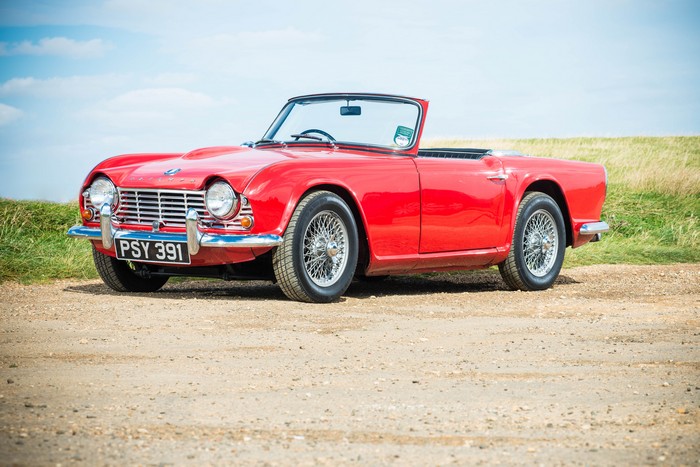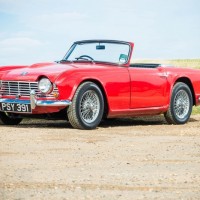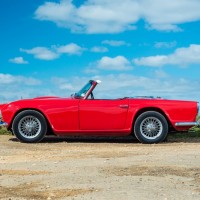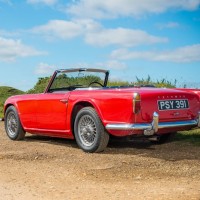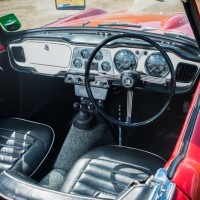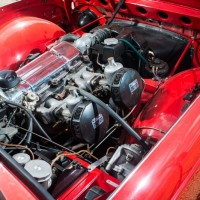The Triumph TR4 was introduced in 1961 to follow its very successful predecessors, the TR2 and TR3. Code named “Zest” during development, the body was given a more modern and updated appearance by Michelotti, but its drive train and chassis remained the same, using the well-proven 4-cylinder pushrod unit; however, its capacity was increased from 1,991 cc to 2,138 cc.
Handling was improved by a three-inch wider track, and steering was also updated to the more precise rack-and-pinion system. Internally, the car gained wind-up windows and the new, angular rear end allowed for a boot with a very reasonable luggage capacity for a sports car. Another innovation was the option of an alloy hard top with a removable roof panel that was five years ahead of Porsche’s famous 911 Targa. A total of 40,235 cars were built between 1961 and 1965, and over the years, this car has become one of Triumph’s most popular sports cars.
The current owner stated that this car has been the subject of a nut-and-bolt restoration over a four-year period by marque specialist Nigel Wiggins. This is backed up with a full photographic record and supporting documentation — with flawless paint finish throughout, superb shut lines and beautiful chrome work. This car really is “best of breed.” It was chosen as the cover car for Bill Piggott’s book on the restoration of the TR4/5/6 range. Finished in Signal Red with contrasting black leather interior and black roof, this car looks absolutely stunning from every angle. It’s petite, low and lovingly detailed. This particular example also benefits from overdrive and a removable rear bench seat.
SCM Analysis
Detailing
| Vehicle: | 1961 Triumph TR4 |
| Number Produced: | 40,253 |
| Original List Price: | $2,849 |
| Tune Up Cost: | $350 |
| Chassis Number Location: | On a small plaque on the scuttle panel adjacent to the windscreen-wiper motor |
| Engine Number Location: | Stamped on the left side of the cylinder block |
| Club Info: | Vintage Triumph Register |
| Website: | http://www.vtr.org |
This car, Lot 125, sold for $41,803, including buyer’s premium, at the Silverstone Auctions NEC Classic Motor Show Sale in Birmingham, England, on November 17, 2012.
By the end of the 1950s, the sports car market was beginning to move away from the raw, bare-bones sports car with no roll-up windows and defrosters that didn’t push enough air to have any real effect. Manufacturers veered toward more comfort, including respectable weather protection and heaters that heated.
The TR4 was born of this movement, and when it made its debut in 1961, Triumph had beaten both MG and Austin-Healey in offering improved specifications.
Farewell flowing lines
The TR4 body was designed by Giovanni Michelotti on a day when he apparently left his French curve at home. Michelotti apparently worked with only a T-square, and the angular body was a complete departure from the design of the predecessor model, the TR3, with those dramatic, swooping curves and doors cut away so deeply that the car looked ready to break in two.
In contrast, the TR4 had a distinctively square shape, which was certainly less inspiring, but it was also more weather-tight and able to accommodate roll-up windows and provide a larger trunk. However, songs are seldom written about cars shaped like shipping crates, so what it lacked in the swoon department had to be made up elsewhere.
Beyond the new body, changes were few. Triumph was in serious financial trouble when the TR4 was designed, and a new drivetrain was out of the question. Instead, the TR3’s 1,991-cc motor was retained and enlarged to 2,138 cc, but the resulting increase in power to 105 horsepower was only five more than that of the TR3A. Additionally, the increased weight of the TR4 — in addition to its increased frontal area — left it unable to offer any performance increase over the TR3A.
The TR4 did gain rack-and-pinion steering and a synchronized first gear, but dealers were so concerned about a potential market rejection of the TR4 that they persuaded Triumph to produce the so-called TR3B, which was offered concurrently with the TR4 in 1962. The TR3B was a TR3A with the TR4’s mechanical specification, and although short-lived, with 3,331 units produced, it did serve to highlight worries that the TR4 would not be seen as enough of an improvement to assure sales success. However, the concerns turned out to be misplaced, as the TR4 wore well, and eventually more than 40,000 were sold.
An early car in spectacular shape
This particular TR4 is a very early example and was originally built with left-hand drive. As Triumph was badly in need of cash at the time the TR4 came out, nearly all of the early cars were made with left-hand drive to bring in U.S. dollars.
Converted to right-hand drive during a thorough restoration by a marque specialist, this TR4 is a fine example with all of the proper components for the early models, including the short-bubble bonnet, gray carpet and convex-glass gauges on a white fascia with an aluminum center portion. This car also lacks a TR4 badge on the trunk lid, which is correct for this very early example.
Donning the concours judge’s white gloves for a moment, we can also note that in the engine compartment the caps on the clutch and brake master cylinders should be steel and painted black, instead of the aluminum types that were for later TR4s, and the battery clamps should be the Lucas helmet-type, but overall this, like the rest of the car, is absolutely excellent.
Although this car sold at a price well above the top of the SCM valuation scale, exceptional cars bring exceptional prices. The early cars are rare and prized by collectors, and this one is well-optioned, with overdrive and the rear bench seat. Add to that the excellent restoration by a marque specialist, and even at this price we can call it slightly well bought. ?
(Introductory description courtesy of Silverstone Auctions.)
